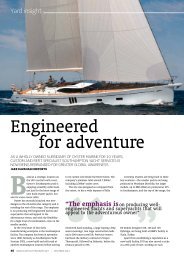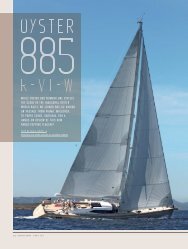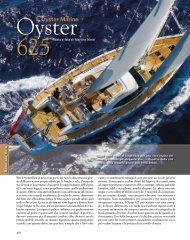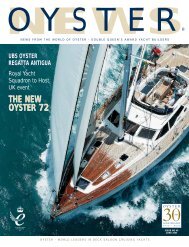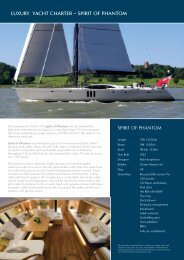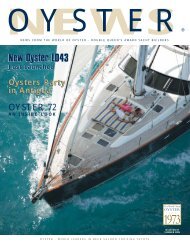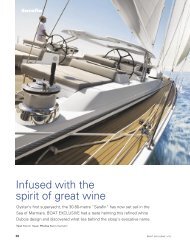Download PDF - Oyster News 66 - Oyster Yachts
Download PDF - Oyster News 66 - Oyster Yachts
Download PDF - Oyster News 66 - Oyster Yachts
You also want an ePaper? Increase the reach of your titles
YUMPU automatically turns print PDFs into web optimized ePapers that Google loves.
While Moana was moored in Cebu Yacht Club we took a day excursion by ferry to Bohol. The main<br />
attractions of Bohol are the Chocolate Mountains and the tarsier, a little monkey. The conical shaped<br />
‘Chocolate Hills,’ as they are called, are well known outside the Philippines. Some geologists believe<br />
that these unique, approximately 40 metre high formations are depositions of coral and<br />
conglomerate stones which were formed millenniums ago by erosion. Beyond the geologic<br />
explanation many mystic legends surround them; The first tells about the fight of two giants who<br />
pelted themselves for days with stones and sand before they made friends. At the end they left the<br />
island tired and exhausted without having cleared up the battlefield. The second legend is a more<br />
romantic one. Aragon, a strong young man fell in love with Aloya, a quiet daughter of a native<br />
headman. Her death broke his heart and Aragon cried bitterly. The proof of his deep grief are the<br />
Chocolate Hills; his tears became the hills.<br />
Tarsier is the name of a small, cute nocturnal forest inhabitant. The tarsier belongs to ghost animal<br />
or to the ghost monkey family and is a type of primate. They look like a mixture between a Gremlin<br />
and ET. An outstanding feature is its big eyes with up to 16 mm in diameter. This size, in comparison<br />
with a human eye, would make it a medium sized apple for a person! There is no other mammal with<br />
such unusual proportions. Interestingly, the tarsiers’ eyes weigh more than their brains. Tarsiers not<br />
only have enormous eyes, they have long feet, too. Their feet have extremely elongated tarsus bones,<br />
which is how they got their name. They are primarily insectivores and catch insects by jumping at<br />
them. They are also known to prey on birds and snakes. As they jump from tree to tree, tarsiers<br />
can catch even birds in motion. Typical of the tarsier is a round head capable of a rotation up to<br />
180 degrees and good hearing.<br />
Unfortunately tarsiers are threatened in the Philippines. The main menace of the tarsier is the<br />
destruction of their living space. In addition, these tiny monkeys are hunted for their meat! Tarsiers<br />
have never bred successfully in captivity. Caged tarsiers have been known to injure and even kill<br />
themselves because of stress. Therefore it is important that the animals are kept in protected<br />
surroundings and locals as well as tourists are informed about the endangered state of the species.<br />
Who knows how long this small ghost will still move in wild nature.<br />
Malapascua<br />
We found Malapascua one of the nicest unspoiled islands we visited. There are no cars and locals<br />
and tourists live in harmony with nature. Electricity flows only between 6pm and 9am – to coincide<br />
with the time when tourists return from excursions.<br />
Malapascua is popular with divers. Two diving areas we particularly liked were Gato Island and a<br />
sunken island called Monad Shoal. Gato is a special habitat under nature conservation and offers<br />
underwater tunnels running from one side of the island to the other and submerged canyons.<br />
After a 40 minute speed boat trip we reached the island. Bear in mind, ‘speed boats’ in the<br />
Philippines are big wooden canoes with two outriggers. ><br />
ABOVE FROM LEFT TO RIGHT:<br />
Jeepneys, the local public transport<br />
A local fisherman in Cebu<br />
One of the never-ending market stalls in Cebu<br />
Yolana and Rolf at the Chocolate Hills<br />
A luxury forest house<br />
A friendly tarsier<br />
OWNER REPORT<br />
www.oystermarine.com 27




